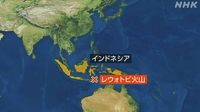A large-scale eruption occurred at the Lewotobi volcano in Indonesia early on March 21, 2025, prompting investigations by authorities regarding a potential tsunami and its effect on Japan. According to the Japan Meteorological Agency, the eruption took place at around 12:40 AM Japan time, spewing ash up to approximately 16,000 meters into the atmosphere.
The potential for a tsunami is a primary concern following large-scale volcanic eruptions. The agency reported that if a tsunami were to occur, it could notably reach Japan's Okinawa Prefecture as early as 3:30 AM on the same day. However, as of the last update at 6:30 AM, there were no significant changes in tide levels reported in either Japan or overseas.
Local Indonesian authorities have reacted swiftly to the eruption, raising the alert level for the Lewotobi Laki-laki volcano to its highest level, indicating the seriousness of the situation. The Lewotobi volcano, located on Flores Island in eastern Indonesia, is known for its geological activity. In recent months, there have been signs of increasing volcanic activity, highlighted by eruptions in November 2024 that led to casualties.
The Japan Meteorological Agency continues to monitor the situation closely, stating, "We are investigating the possibility of a tsunami associated with this eruption and will provide updates as more information becomes available." Their assessments indicate that, while the eruption is significant, the immediate tide changes are not currently alarming.
International agencies and experts are also on high alert, watching for any developments related to potential tsunami waves traveling towards Japan or other regions around the Pacific. The ongoing activities at Lewotobi highlight the unpredictable nature of volcanic eruptions and their capacity to cause widespread concern beyond their geographical location.
This latest eruption is not an isolated occurrence for the Lewotobi volcano, which has historically shown a pattern of eruptions, with the most recent notable events occurring in November 2024. This history has prompted concerns about the stability of the region and the potential for another disaster. The volcano is part of the Pacific Ring of Fire, known for its frequent seismic and volcanic activity, making it an area of keen interest for geological studies.
While there are no significant recorded changes in tide levels so far, the Japan Meteorological Agency emphasized the importance of remaining vigilant. They are working in coordination with local authorities to monitor volcanic activity and potential tsunami threats, and residents and visitors in Japan are urged to stay informed through official channels.
Experts acknowledge that volcanic eruptions can sometimes lead to atmospheric pressure waves capable of inducing tsunamis, a phenomenon that adds complexity to monitoring these events. The concern, therefore, is not merely the eruption itself but also the cascade of reactions it may trigger in surrounding ecosystems and human communities.
For those living in coastal areas vulnerable to such natural disasters, the combination of an active volcano and the potential threat of tsunami waves typically heightens anxiety. Community preparedness plans are crucial, and educational outreach regarding the implications of volcanic activity is vital in lessening the impact of sudden natural events.
In summary, the situation remains fluid as authorities strive to ascertain the full implications of the Lewotobi eruption. Timely communication of information will be essential as scientists assess the geological and environmental changes stemming from this event. The hope is that with rigorous monitoring and readiness measures, any potential impact can be mitigated.
This crucial information will continue to unfold in the coming hours as the Japan Meteorological Agency, local authorities, and international observers work to keep the public informed and safe amidst this natural occurrence.






